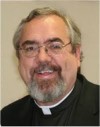Lectionary blog for Dec. 13, 2015
Third Sunday in Advent
Text: Zephaniah 3:14-20; Isaiah 12:2-6;
Philippians 4:4-7; Luke 3:7-18
Our Gospel lesson for today centers on John the Baptist’s call to repentance. Repentance begins in the recognition of personal involvement in and responsibility for the evil that surrounds us. John’s call to repentance is a call for us to look at ourselves and to see in ourselves and our attitudes and our actions the things that lead to evil in the world. John’s call to repentance is a call to look at our way of being in the world and in relationship to one another and to repent of those things that cause harm to ourselves and others.
John’s call is a call to repentance, but all too often we make it as far as confession and then we stop. Confession is the admission that there are indeed things we do in life that are wrong. Repentance is the change of life that follows. Most of us make confession but go no further.
One day in Nashville I went to the YMCA to pick up my son. As I approached the entrance, a very angry mother barged out the door followed by a girl about 4 and a boy about 7. The boy was saying, “I told you I was sorry.” And the mother turned and said, hissing between her teeth, “Sorry doesn’t get it anymore. I want you to stop doing it!”
True repentance combines confession, “I’m sorry,” with what the old prayer books referred to as amendment of life. The Greek word translated here as “repentance” is not really a religious or theological word. It is “metanoia,” which is an ordinary, everyday word in Greek. It means to turn around and go the other way; to stop going in one direction and to start going in a different direction. This is a matter of the mind, heart and will. Metanoia refers to changing one’s mind, which in turn changes one’s actions. Repentance is the two-part action of realizing you are going the wrong way and then acting to turn around and go the right way.
The gospel, the good news, is rooted in this simple act of repentance, because we can only stop going the wrong way if we have been shown the right way. The gospel comes to turn us around, to show us the way, to warn us off the danger in the path we are taking, and to provide for us a route to safety.
One of my very earliest memories is of a bright, summer day on the farm. I was playing in the backyard, under the apple trees. Daddy was mowing hay in a field next to the house.
Mama called to me from the back porch. She sent me into the field with a quart jar full of ice water for Daddy. As I started out across the field, Daddy stopped the tractor and got off and started yelling at me. “Delmer, Delmer. STOP! GO BACK, GO AROUND! STOP!”
Now, even as a 4-year-old, I knew that the shortest distance between two points is a straight line, so Daddy’s instructions made no sense to me. But I stopped and thought about it a minute. Though I could see no reason to stop and go back and go around, it was my Daddy telling me this, so I backed up and followed his instructions. When I got to the tractor, I discovered that he had run over a yellow jackets’ nest in the ground and stirred them up. The angry swarm lay directly in the path I was following.
So it is with us. We may not be able to see the destruction that lies upon the path we have chosen, but we have a loving God who warns us to turn from the path of self-deception. The gospel is that Jesus came into the world to open for us the way to God – to unblock the path and to call us to follow the way. For us to turn from the way we have been going, we have to see that we are being called to turn from danger to security, from evil to good, from wrong to right, from our way to God’s way.
The way is being prepared, the opportunity is here. John’s call is ringing in our ears, “REPENT, REPENT! Turn back! Go the other way!” This is an invitation to look at our lives and change direction, avoiding destruction and becoming a part of God’s new reign of grace, love and peace.
No wonder Luke calls it “good news.”
Amen and amen.




